AMD Ryzen 9 5980HS Cezanne Review: Ryzen 5000 Mobile Tested
by Dr. Ian Cutress on January 26, 2021 9:00 AM EST- Posted in
- CPUs
- AMD
- Vega
- Ryzen
- Zen 3
- Renoir
- Notebook
- Ryzen 9 5980HS
- Ryzen 5000 Mobile
- Cezanne
CPU Tests: Simulation
Simulation and Science have a lot of overlap in the benchmarking world, however for this distinction we’re separating into two segments mostly based on the utility of the resulting data. The benchmarks that fall under Science have a distinct use for the data they output – in our Simulation section, these act more like synthetics but at some level are still trying to simulate a given environment.
DigiCortex v1.35: link
DigiCortex is a pet project for the visualization of neuron and synapse activity in the brain. The software comes with a variety of benchmark modes, and we take the small benchmark which runs a 32k neuron/1.8B synapse simulation, similar to a small slug.
The results on the output are given as a fraction of whether the system can simulate in real-time, so anything above a value of one is suitable for real-time work. The benchmark offers a 'no firing synapse' mode, which in essence detects DRAM and bus speed, however we take the firing mode which adds CPU work with every firing.
The software originally shipped with a benchmark that recorded the first few cycles and output a result. So while fast multi-threaded processors this made the benchmark last less than a few seconds, slow dual-core processors could be running for almost an hour. There is also the issue of DigiCortex starting with a base neuron/synapse map in ‘off mode’, giving a high result in the first few cycles as none of the nodes are currently active. We found that the performance settles down into a steady state after a while (when the model is actively in use), so we asked the author to allow for a ‘warm-up’ phase and for the benchmark to be the average over a second sample time.
For our test, we give the benchmark 20000 cycles to warm up and then take the data over the next 10000 cycles seconds for the test – on a modern processor this takes 30 seconds and 150 seconds respectively. This is then repeated a minimum of 10 times, with the first three results rejected. Results are shown as a multiple of real-time calculation.
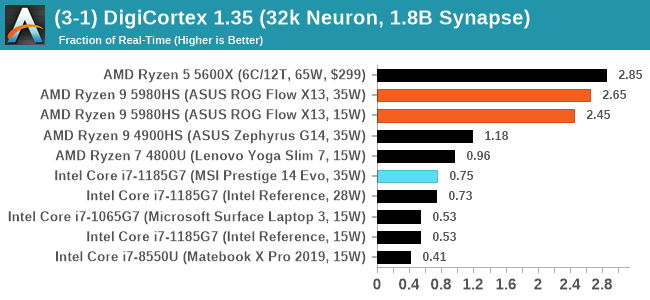
DigiCortex seems to have taken a shine to Zen 3, especially processors with a single chiplet of cores. Intel can't seem to compete here.
Dwarf Fortress 0.44.12: Link
Another long standing request for our benchmark suite has been Dwarf Fortress, a popular management/roguelike indie video game, first launched in 2006 and still being regularly updated today, aiming for a Steam launch sometime in the future.
Emulating the ASCII interfaces of old, this title is a rather complex beast, which can generate environments subject to millennia of rule, famous faces, peasants, and key historical figures and events. The further you get into the game, depending on the size of the world, the slower it becomes as it has to simulate more famous people, more world events, and the natural way that humanoid creatures take over an environment. Like some kind of virus.
For our test we’re using DFMark. DFMark is a benchmark built by vorsgren on the Bay12Forums that gives two different modes built on DFHack: world generation and embark. These tests can be configured, but range anywhere from 3 minutes to several hours. After analyzing the test, we ended up going for three different world generation sizes:
- Small, a 65x65 world with 250 years, 10 civilizations and 4 megabeasts
- Medium, a 127x127 world with 550 years, 10 civilizations and 4 megabeasts
- Large, a 257x257 world with 550 years, 40 civilizations and 10 megabeasts
DFMark outputs the time to run any given test, so this is what we use for the output. We loop the small test for as many times possible in 10 minutes, the medium test for as many times in 30 minutes, and the large test for as many times in an hour.
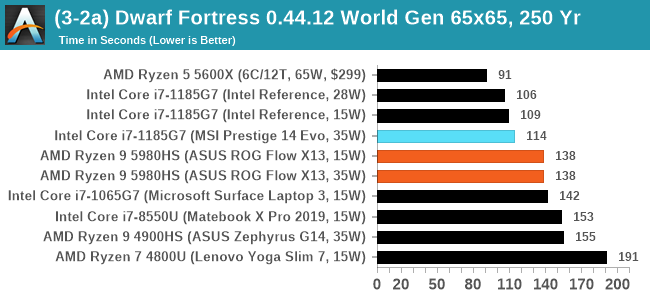
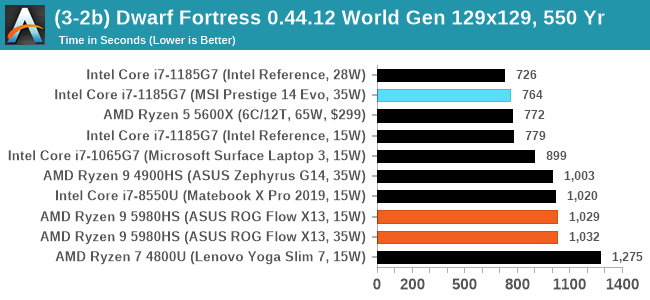
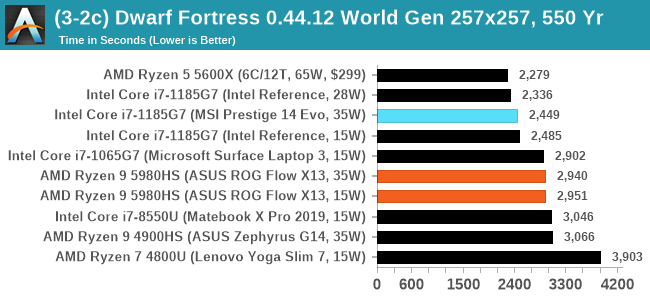
DF has historically been an Intel favorite, and we're not seeing much of a speedup for mobile Zen 3 over mobile Zen 2 here.
Dolphin v5.0 Emulation: Link
Many emulators are often bound by single thread CPU performance, and general reports tended to suggest that Haswell provided a significant boost to emulator performance. This benchmark runs a Wii program that ray traces a complex 3D scene inside the Dolphin Wii emulator. Performance on this benchmark is a good proxy of the speed of Dolphin CPU emulation, which is an intensive single core task using most aspects of a CPU. Results are given in seconds, where the Wii itself scores 1051 seconds.
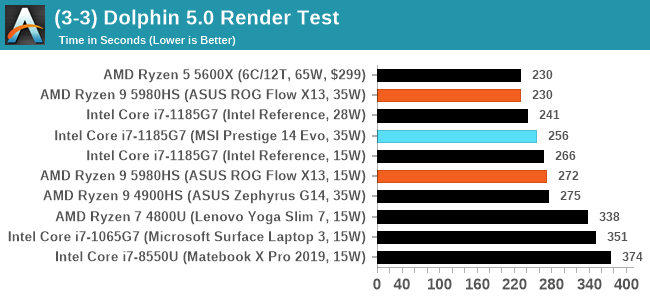
The 35W variant of Cezanne pushes through here, matching the desktop processor, and a sizeable performance jump over the previous generation Renoir.












218 Comments
View All Comments
Ptosio - Tuesday, January 26, 2021 - link
ARM is not some magic silver bullet - MediaTech has vast experience with ARM but are their chromebook chips any way close to Apple M1? (or Zen3 for that matter?)And remember AMD is yet to get acess to the same TSMC process as Apple - maybe once they're on par, large part of that efficiency advantage dissapears?
ABR - Wednesday, January 27, 2021 - link
AMD has K12, which Jim Keller also worked on, waiting in the wings. Most assuredly they have continued developing it. Whether it will play in the same league with M1 remains to be seen, but they also have the graphics IP to go with it so they could likely come out with a strong offering if it comes to that. Not sure what Intel will do..Deicidium369 - Wednesday, January 27, 2021 - link
ancient design, far exceeded by even 10 year old ARM designs.Spunjji - Thursday, January 28, 2021 - link
You say some really silly thingsSpunjji - Thursday, January 28, 2021 - link
"Apple will outclass everything x86 once they introduce their second gen silicon with much higher core count and other architectural improvements."I'll believe it when I see it. Their first move was far better than expected, but it doesn't come close to justifying the claims you're making here.
Glaurung - Saturday, January 30, 2021 - link
M1 is Apple's replacement for ultra-low power, nominal 15w Intel chips. Later this year we will see their replacement for higher powered (35-65w) Intel chips. Nobody knows what those chips will be like yet, but it's pretty obvious they'll have 8 or 16 performance cores instead of just 4, with a similar scale up of the number of GPU cores. They'll add the ability to handle more than 16gb and two ports, and they will put it in their high end laptops and imac desktops. Potentially also on the menu would be a faster peak clock rate. That's not an "I'll believe it when I see it," that's a foregone conclusion. Also a foregone conclusion: next year they will have an even faster core with even better IPC to put in their phones, tablets, and computers.As of last year, Apple's chips had far better IPC and performance per watt than anything Intel or AMD could make, and they only fell short on overall performance due to only having 4 performance cores in their ultra-low power chips.
(For the record, I use Windows. But there's no denying that Apple is utterly dominating in the contest to see who can make the fastest CPUs)
GeoffreyA - Sunday, January 31, 2021 - link
Apple will release faster cores but so will AMD. And now that they've got an idea of what Apple's design is capable of, I'm pretty sure they could overtake it, if they wanted to.GeoffreyA - Sunday, January 31, 2021 - link
As much as I hate to say it, the M1 could be analogous to Core and K8 in the Netburst era. The return to lower clock speeds, higher IPC, and wider execution. Having Skylake and Sunny C. as their measure, AMD produced so and so (and brilliant stuff too, Zen 3 is). Perhaps the M1 will recalibrate the perf/watt measure, like Conroe did, like the Athlon 64 did.I've got a feeling, too, that ARM isn't playing the role in the M1 that people are thinking. It's possible the difference in perf/watt between Zen 3 and M1 is due not to x86 vs. ARM but rather the astonishing width of that core, as well as caches. How much juice ARM is adding, I doubt whether we can say, unless the other components were similar. My belief, it isn't adding much.
Farfolomew - Thursday, February 4, 2021 - link
Very nice comment, and this little thread is a really fascinating read. I've not thought of the comparisons of the P4 -> Core2Duo Mhz regression, but I really think you're on to something here. The thing is, this isn't anything new with M1, Apple has been doing it since the A9 back in 2015, when it finally had IPC parity with the Core M chips. The M1 is just the evolution and scaling up to that of an equivalent TDP laptop chip that Intel has been producing.So the question, then, is, if it's not the "ARM" architecture giving the huge advantages, why haven't we seen a radical shift in the x86 technology back to ultra wide cores, and caches? Or maybe we are, incrementally, with Ice/Tiger Lake, and Zen 2/3/4?
Very fascinating times!
GeoffreyA - Sunday, February 7, 2021 - link
"Or maybe we are, incrementally, with Ice/Tiger Lake, and Zen 2/3/4?"I think that sums it up. As to why their scaling is going at a slower rate, there are a few possible explanations. Likely, truth is somewhere in between.
Firstly, AMD and Intel have aimed for high-frequency designs, which is at loggerheads with widening of a core. Then, AMD has been targeting Haswell (and later) perf/watt with Zen. When one's measure is such, one won't go much beyond that (Zen 2 and 3 did, but there's still juice in the tank). Lastly, it could be owing to the main bottleneck in x86: the variable-length instructions, which make parallel decoding difficult. Adding more decoders helps but causes power to go up. So the front end could be limiting how much we can widen our resources down the line.
Having said that, I still think that AMD's ~15% IPC increase each year has been impressive. "The stuff of legend." Intel, back when it was leading, had us believe such gains were impossible. It's going to be some interesting years ahead, watching the directions Intel, Apple, and AMD take. I'm confident AMD will keep up the good work.